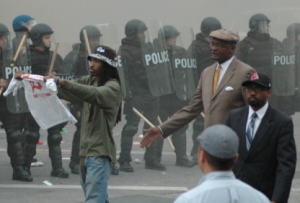
U.S. Launches ‘Police Data Initiative’

As part of an effort to repair badly strained relations between municipal police forces and the communities they are supposed to serve, the White House launched a “Police Data Initiative” this week in an attempt to fix community policing.
A key focus of the effort will be pouring through video from body-worn cameras.
The initiative, launched during a visit by President Obama to Camden, N.J., builds on the Task Force on 21st Century Policing launched last December. The issue of community policing has taken on greater urgency in the wake of a series of racially charged incidents, including rioting in Baltimore after Freddie Gray, a 25-year-old African American, died while in police custody. The Baltimore State’s Attorney filed criminal charges against six police officers in connection with Gray’s death on May 1.
Megan Smith, the U.S. chief technology officer, noted in a May 18 blog post: “Many of the task force’s recommendations emphasize the opportunity for departments to better use data and technology to build community trust. As a response, the White House has launched the Police Data Initiative, which has mobilized 21 leading jurisdictions across the country to take fast action on concrete deliverables responding to these task force recommendations in the area of data and technology.”
Along with Camden, other cities participating in the data initiative include: Austin, Texas; Charlotte, N.C.; Dallas; Indianapolis; Knoxville, Tenn.; the City and County of Los Angeles; Louisville, Ky.; New Orleans; Philadelphia; and Richmond, Calif.
Analyzing video data collected by body-warn cameras is a key focus. Smith and Roy Austin, deputy assistant to the president for urban affairs, said participating cities and the U.S. Justice Department would work with universities and other researcher partners to “identify opportunities to coordinate body-worn camera research to help avoid unintended overlap, maximize the coverage of research topics and increase cross-learning.” The initiative will also leverage experts in advanced video analysis “to identify opportunities to help police departments maximize the value of the thousands of hours of video body-worn cameras will produce.”
The White House said the University of Chicago would provide five data science fellows to work with participating police departments over a 14-week period starting in late May. The effort is expected to yield new data analysis tools “that will help police departments identify the behaviors most indicative of later problems.”
The officials cited a four-year-old body camera initiative in Oakland, Calif., in which the police department has worked with researchers from Stanford University. The collaboration has so far yielded automated tools used to sift through data on police encounters with the community.
Despite these efforts, Oakland and Richmond, Calif., have some of the highest crime and murder rates in California. In April, protesters block Interstate 880, the main thoroughfare in the East Bay, to highlight what they said were instances of police brutality in the city. In December, protesters chained themselves to the Oakland police headquarters.
The White House said all participating police departments would release a combined total of 101 datasets that have not yet been publicly released. The data includes uses of force, pedestrian and vehicle stops as well as officers involved in shootings.
A fact sheet on the Police Data Initiative is available here. The Justice Department announced a $20 million Body-Worn Camera Pilot Partnership Program earlier this month designed to respond quickly to growing complaints about police abuses.
Recent items:
Analytics Set to Take Down ‘Felony Lane’ Gang
Police Push Limits of Big Data Technology




























